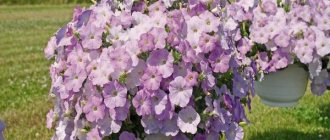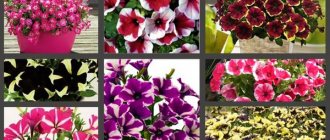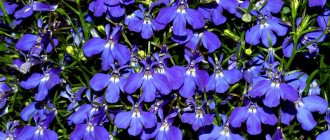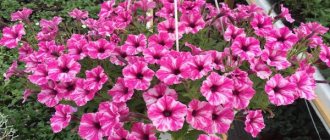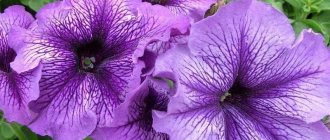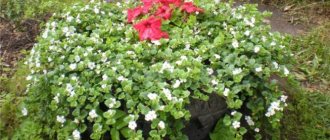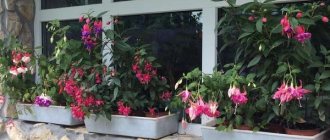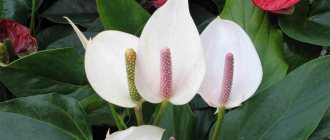Petunias are especially loved by gardeners. They are grown on the territory of personal plots, on the windowsills of apartments, in suspended structures on terraces and balconies. The difference between ampelous petunia and cascade petunia is due to the peculiarities of the placement of these crops. Varieties of ampelous petunias are created in order to plant them as part of flower structures and decorate gazebos with them. Cascading petunias have significant differences, although they are also in demand when grown in hanging pots.
Ampelous and cascading petunia: the difference
At first glance, the cascade and ampelous varieties of this plant are very similar with their long branching shoots.
But in fact, despite the flowing branches and bright simple flowers, there is a difference between them. This division was adopted due to the fact that their bushes are formed differently, and there are also differences in the size of the flowers. Ampelous petunia
What is ampelous petunia
This group includes plants that, thanks to their long, hanging shoots, can be used for growing in hanging containers and pots. Representatives of this variety are distinguished by long and abundant flowering. In this case, the flowers can have the shape of a bell or a funnel, and their shade can be white, purple, crimson, etc. There are hybrids with a flower diameter of 15-90 mm, with colored veins, and a spectacular dark core.
Important! Ampelous varieties also feel good on a flat surface, then they form a spectacular variegated carpet
What is petunia cascade
A very beautiful variety. Its flowers can be red, pink, or purple; there are even fantastic combinations of two shades. How cascading petunia differs from ampelous petunia is its size. Representatives of this group require much more living space.
For normal development of one specimen, a container with a volume of at least 5 liters is required. If you want to grow two flowers in one container, then you should count on 15 liters at once. It is not surprising that such containers are not used as hanging ones. Although in a large container, a plant of this type can easily stand on the balcony all summer. It is not at all necessary to plant it in a flowerbed as a bush variety.
Cascade of flowers
How to distinguish ampelous petunia from bush petunia
In addition to the listed varieties, there is another large group - the bush variety. It is considered the most numerous and diverse in terms of appearance, since it includes both low-growing varieties, in which the flower diameter does not exceed 5 cm, and taller and larger plants, with flowers up to 16 cm in diameter.
The main criterion for classifying a variety or hybrid into this group is that the shape of the bush can be maintained without special pruning. At the same time, the bush can be very lush, but it does not need special care. It is enough to simply pinch the tops of the stems so that the plant sends out side shoots.
Both the hanging and bush varieties are very similar, especially at the seedling stage. In order to say with confidence which annual plant we are talking about in a particular case, you need to wait until the formation of side shoots begins. Even in small plants, quite noticeable differences appear at this stage.
Ampelous varieties begin to send out side shoots almost immediately, so the plant takes on the shape of a bush, but it does not have any one distinct central stem. In bush petunia, if you do not pinch the branches, side shoots will not appear, but the main stem will stand out clearly, and over time, buds will begin to bloom on it.
Important! It is almost impossible to distinguish seedlings of ampelous petunia from bush or cascade ones. Small plants of these species look the same and have no significant differences
All that remains is to wait for the moment when shoots begin to form.
Bush variety
Main differences
The differences between cascade and ampel types can be determined by a combination of several characteristics.
| Ampelnaya | Cascade | |
| Length and type of shoots | Up to 1.2 m, hanging down. | Up to 1.5 m, can wrap around supports and spread along the ground. |
| Size and color of buds | The flowers are of different sizes, bell-shaped, and can be one-color or two-color. | Large buds are the same size, the shade of the petals may be different, but the flowers are always monochromatic. |
| Features of care | They require watering and do not tolerate waterlogging or drought. | Regular watering is required and can tolerate short periods of drought, provided they grow in shaded areas. |
| Feeding | They need fertilizing throughout bud setting and flowering. They react positively to root applications of potassium-phosphorus mixtures. | |
| Where are they planted? | On hanging flower pots, prefabricated flower beds, on balconies, terraces, as a ground cover plant with obligatory pinching. | On hanging structures, in wide baskets, along walls to form a flowering hedge, to cover an area of soil. |
| How long does flowering last? | With timely removal of faded buds, flowering can be extended until the onset of frost. | From June to September. |
Description of ampelous petunia
Ampelous petunia was created specifically for growing in hanging structures. The name of this species comes from the German phrase meaning “hanging vase.” The external feature of petunia is characterized in a similar way. When grown on hanging structures, the stems hang down, forming a colorful cloud of small bell-shaped inflorescences.
Over the past decades, various varieties of petunias have been developed that have advantages over early hybrids. Their adaptive properties have been improved by selection methods; botanists are constantly working to extend the flowering period of hybrids and increase their frost resistance.
What does it look like
The main differences between ampelous and cascading petunias concern the appearance of the plants. Experienced flower growers can tell by the shoots and flowers which flower is in front of them: an ampel type or a cascade type.
Ampelous petunia can decorate any area of the garden, but when placing it, you should take into account the features of its appearance:
- Escape. The length of the stems depends on the variety: they can grow from 30 to 120 cm. The difference between ampelous petunia is that its shoots hang down from the very beginning of development, without falling apart on the sides of the flowerpot or pot. This difference is often used for wall decoration. Drooping shoots can form a kind of flower curtain.
- Leaves. Covered with light fluff on the inside. In young flowers they can be small, in adult plants they become larger.
- Flowers. They are formed along the surface of the axils of each shoot. They are shaped like a bell. Their size depends on the variety. The color of the petals is particularly bright; flowers can often be two-colored, while the edges and outer part of the petals remain light, and the middle becomes brighter.
The difference between this variety is that the flowers are formed along the entire length of the shoots and can also have different sizes. The buds that form closer to the root are slightly larger than those that grow outside the pots, on hanging shoots.
Features of cultivation
To grow hanging petunia, you need to take into account some features. Annual petunias of the ampelous type are grown by seedlings. Seeds are sown on the surface of the prepared soil. Planting dates depend on the climatic characteristics of the region. Typically, sowing occurs at the end of March - beginning of April, so that planting in open ground areas can be carried out when the air is warm enough.
During the period when the plant forms buds and begins to bloom, it needs regular watering and feeding. The root system is located close to the surface, so pots with a wide top are used for growing. There should be no stagnation of moisture on the soil surface, so as not to trigger the development of a fungal process.
Fertilizers for the ampel type are applied according to the following scheme: 3 times in 1 month with complexes that contain potassium and phosphorus. For abundant flowering, follow several basic rules:
- faded buds are promptly removed along with the stalk, so as not to slow down the process of formation of new buds;
- regularly pinch shoots, which can weigh down the bush and prevent flowering.
Cantilever varieties, unlike cascade ones, can be immediately planted in open ground areas. They form a whole carpet, so they are never planted next to other small flower crops.
Photo
Check out the photos of both types of flowers to understand the differences between them.
Ampelnaya:
Cascade:
Difference in care
In general, there are few differences between these two types of petunias, but they exist. And these differences determine the difference in care.
Pinching seedlings
- In the ampelous petunia, the shoots grow only downward from the very beginning, and in order to have more of them, the sprouts of the ampelous petunia are pinched.
- In a cascading plant, shoots can grow in different directions. There is no need to pinch out its sprouts; this reduces the growth rate and weakens the plant. And without this procedure, there are many buds, and subsequently flowers, and the vines fall down under their weight.
Shoot care
- The shoots of cascading petunia are thicker, more powerful, strong, long, and produce more shoots.
- The canopy shoots are thinner, weaker, and must be handled very carefully so as not to break them.
Trimming flowers and seed pods
ATTENTION: Flowers of cascading petunia are usually larger than ampel petunia, identical on one bush. In the ampelous petunia, the size and color of the flowers are different on the same plant, in general they are smaller.. In order for the bush to always look beautiful, the ampelous petunia must be trimmed at least once a week
In this case, faded inflorescences should be torn off along with the seed pods so that the plant does not waste energy on setting fruit. If this is not done, the petunias enter the fruiting phase, all efforts are spent on setting seeds, new flowers are not formed and a complete loss of decorativeness occurs. Read more about caring for ampelous petunia here
To ensure that the bush always looks beautiful, ampelous petunia must be trimmed at least once a week. In this case, faded inflorescences should be torn off along with the seed pods so that the plant does not waste energy on setting fruit. If this is not done, the petunias enter the fruiting phase, all efforts are spent on setting seeds, new flowers are not formed and a complete loss of decorativeness occurs. Read more about caring for ampelous petunia here.
Cascade petunia is not pruned during the entire flowering period.
Placement in flowerpots and watering
For hanging varieties of petunias, small hanging pots or flowerpots will be sufficient. However, it should be remembered that the green mass of this plant is very large, and the root system is limited. Therefore, ampelous petunia needs to be watered frequently, in hot weather - up to twice a day. You can add hydrogel to the soil - then the moisture will remain longer.
When watering, you need to make sure that the water penetrates both the upper and lower layers of the soil and does not pour out of the pots too quickly. To do this, place a vase of flowers completely in a container of water for a short time. We looked at the nuances of growing ampelous petunia in flowerpots here.
Cascading petunias are planted in large flowerpots with a volume of at least 5 liters, as well as in flower beds, alpine slides, on supports or hedges. Water them less frequently as the soil dries out. Be sure to loosen, which will provide good air exchange for the roots of the petunias.
Feeding
- During flowering, cascade petunia is fed once every 7–10 days with complex water-soluble mineral fertilizers with a high content of potassium and phosphorus.
- Ampel varieties of petunias are fed more often - once every 5-7 days, some varieties even once every 2-3 days with complex liquid fertilizer also with a high content of phosphorus and potassium.
TIP: If you fertilize frequently, fertilizers should be diluted with water three to four times weaker than indicated in the instructions.
How to choose?
The huge variety of varieties and types of petunias can make an inexperienced gardener seriously confused. Indeed, it is not immediately clear whether ampelous or cascading petunias are suitable for decorating a terrace, summer cottage or balcony. But it's actually quite simple. You just have to pay attention to the size of the area that you want to enliven with these lovely flowers.
Ampelous petunia will look great in large garden areas , but may look a little tacky on a tiny terrace.
For decorating small spaces, a cascading petunia climbing along a support, which does not take up much space, is more suitable. But if the size allows, you can turn around and combine both types of flowers, creating a delightful flower arrangement.
Other varieties and hybrids of petunias are no less attractive. Read on our portal about low-growing, dwarf and vegetative species.
Petunias are rightfully one of the best flowers for decorating your home and garden. They will organically fit into almost any space, and even the most picky gardener will definitely find the variety that suits his heart. But in any case, no matter what petunias you choose, these flowers will delight your eye with their unpretentiousness and exquisite beauty for a very long time.
What is the difference between growing cascading petunias and hanging petunias?
The first thing that inexperienced gardeners should remember is that the bright cascade does not require pinching! The procedure will adversely affect the development of the tropical guest, weaken the immune system, and slow down flowering.
The described type of exotic forms massive growth. When planted in a flowerbed, the bush grows quickly, occupying an area of up to two square meters. Such a large representative of the flora does not need neighbors. Even relatives are planted at a distance of at least half a meter. Otherwise, competition for soil resources and moisture arises. For comfortable living in a limited space, each specimen will require a container with a volume of at least five liters. If you want to get a multi-colored cascade, then look for a flowerpot or flowerpot of the appropriate size and do not plant more than 2-3 individuals in a container.
Advice! Hanging flower beds in the form of trees (pictured below) are especially popular. As the bushes grow, the metal crown will be completely covered with a flower cascade - a stunningly effective solution for landscape design!
Sow in a common container: classic method
When planting in a common container, it is first filled with soil with a layer of 4-6 cm. There should be about 3 cm between the soil level and the upper edge of the container so that the seedlings have enough vertical space. The soil is leveled, compacted and watered abundantly. After this, they begin sowing. Regular (not coated) seeds are poured onto a light plate, and using a toothpick or wooden skewer, previously soaked in water, they are transferred one by one to the surface of the soil.
The seeds are laid out on the surface, not buried and not sprinkled with soil on top.
The peculiarity of sowing petunia is that the seeds should be placed ON the ground, and not in depth. If there is a layer of soil on top, they will not germinate.
After the required number of seeds have been spread out, they are sprinkled with water from a spray bottle on top, and then the container is closed with a lid and put in a warm place.
Features of growing ampelous petunia
To get abundant flowering of petunia in open ground from the beginning of summer, the seeds are sown in February-March. The soil is prepared nutritious, loose and with a neutral reaction, you can sow petunia in peat tablets. Small seeds cannot be sprinkled with soil; it is enough to scatter them on the surface.
At a temperature of 25 degrees, seeds germinate within a week
It is important to create comfortable conditions for seedlings:
- sufficient lighting (10-11 hours),
- watering through a tray with warm, settled water,
- picking at the age of 2 true leaves,
- fertilizing with complex mineral fertilizers for flowers every 2-3 weeks.
More information on when to plant petunia seedlings and how to do it.
Where to place it?
It is customary to place ampelous petunia in hanging baskets, flowerpots and pots. The volume of soil per plant requires at least 5 liters. Containers with flowers are placed not only on verandas, balconies and gazebos; a basket with hanging petunia hanging on tree branches in the garden looks original. The lacy shadow from the crown does not harm the plants.
You can decorate a fence with boxes of flowers, completely hiding it under the flowers, or an unsightly pillar on the site. Just don’t plant ampelous petunia in a flowerbed with other flowers; the plant, which grows powerfully in different directions, will completely overwhelm its neighbors.
Faded flower buds must be removed in time, along with broken twigs and dried leaves. During the rainy season, it is worth thinning out lush bushes to avoid rotting of the stems.
Important! It must be remembered that in small containers the soil dries out very quickly, so flowers need watering more often. With proper care and regular feeding, ampelous petunia will delight you with luxurious flowering from the beginning of June until frost
With proper care and regular feeding, ampelous petunia will delight you with luxurious flowering from the beginning of June until frost.
If desired, you can take cuttings from an adult plant and root them in a pot of nutritious soil. In this case, petunia will overwinter well at home. For full flowering, in this case, additional lighting will be required.
Which type to choose for a garden plot
For cultivation, ampel or cascade varieties are chosen, taking into account their differences from each other. In addition, the determining factor is the main purpose of the culture:
- To cover areas of soil with a flower carpet that will bloom throughout the summer, it is recommended to choose cascading petunias. The shoots, if you do not pinch them, will grow independently over the entire surface, without requiring additional care;
- To decorate walls and create the feeling of a hanging structure, hanging varieties are chosen. They are used to decorate arches, as well as the upper tiers of tall flower arrangements;
- Both ampelous and cascading varieties are suitable for growing in floor vases. Their difference at the initial stage of growth when using this option will be almost imperceptible. If you regularly shape the bush by pinching, the differences can be minimized;
- To decorate walls and create a “hedge” effect, choose cascading petunia. Its difference with this growing option is the ability to wrap around a support and completely cover it.
Description of ampelous petunia
First you need to figure out what the word “ampel” means? The name comes from the German word ampel - hanging vase. Hence, flowers that are grown in hanging flowerpots, flowerpots, and baskets are called hanging flowers.
Ampelous has elastic flowing shoots. Their length can reach from 30 to 120 cm. The leaves are soft, green with slight pubescence. On the shoots there are many flowers shaped like a bell. Their diameter ranges from 3 to 10 cm depending on the variety.
Appearance also depends on the variety. The stems point down, hang down, have loops, and are most often used for hanging pots and balcony boxes. Flowers can be one-color or two-color. The middle is a more saturated shade.
Note! Both pure and hybrid varieties of ampelous petunia are available on sale.
Varieties
Ampelous petunia comes in unusual shades and different shapes. The hybrid varieties introduced over the last 10 years are more stable and feature abundant and long-lasting flowering.
The best varieties of ampelous petunia are:
- Surfinia - the variety comes in a variety of shades (grown using cuttings). It is characterized by good branching and resistance to weather conditions.
- Snow Queen - shoots of medium length, white flowers with a delicate aroma.
- Velvet - leaves and flowers have a velvety surface. It is considered a good honey plant.
- Avalanche - a series of varieties represented by “Avalanche Pink”, “Avalanche White” and “Avalanche Purple”, characterized by high decorativeness and a long flowering period, increased fragility.
- Opera - flowers are predominantly red, pink and white, the buds are small.
- Ekaterina - belongs to the hybrid varieties. The flowers are about 5 cm in diameter and have a yellowish-reddish tint.
Planting and care
Proper care and cultivation of ampelous petunia ensures intensive flowering for several months. If this variety grows in standing containers, then the middle becomes less lush and thins out. Therefore, it is preferable to use hanging flower pots.
Features of planting and caring for flowers:
- It is recommended to sow seeds in spring. Many small-flowered varieties bloom after 10 weeks, and large-flowered varieties after 12 weeks.
- The soil is selected that is nutritious and loose, pre-moistened before sowing. Provides good drainage. Pebbles or expanded clay are placed at the bottom of the container.
- Seeds of ampelous petunia are pre-soaked in potassium permanganate.
- Sowing needs to be sparse. The optimal temperature is 21-24 degrees. Already 7-10 days after sowing, if all conditions are met, the first shoots appear.
- After the appearance of several full-fledged leaves, the seedlings dive into a permanent place; 3-4 plants should be planted in a pot.
- In order for the flower to take root, it is fed with complex fertilizers once every 4 weeks. For abundant flowering, fertilizers with a predominance of potassium and magnesium are applied.
- Caring for the plant consists of watering and regularly loosening the top layer of soil. Moisturizing should be plentiful, in hot weather - 2 times a day.
- For lush flowering and a beautiful appearance, all dried buds are removed.
- The place for transplantation is chosen to be sunny, without drafts.
Plant decoration on video:
Petunia is propagated much faster by cuttings. This is a good way to decorate your garden without purchasing a lot of planting material. Flowering with such propagation is observed after a month. The procedure can be carried out in spring and summer. On the southern side of the plant, the upper part of the shoot is cut off; if there is a flower, it must be removed.
In the spring, rooting is carried out in sand; in the summer, sand can be mixed with soil from the site in a ratio of 1 to 1. The soil mixture is disinfected with a solution of potassium permanganate.
Before planting, dip the stem of the cutting in the preparation “Kornevin” and bury it 2 cm into the ground, cover it with a plastic container to create a greenhouse effect. After 2 weeks, they are planted in a permanent place. To obtain beautiful flowing loops, the plant is not pinched.
Note! You should not plant ampelous petunia with other plants, as it will not allow them to grow.
Variety of ampelous petunias in the photo:
Problems during cultivation
If not cared for properly, petunia can get sick, most often these are infections that cannot be treated. To prevent the entire flowerbed from becoming infected, plants infected with viruses and bacteria must be removed. To prevent diseases, you should promptly remove dead leaves and shoots, avoid excessive watering and choose disease-resistant varieties.
Attention! Buy seeds only from stores that sell certified products.
Additional information about the difference between ampelous and cascading petunias can be gleaned from the video.
Related Posts
- How to pinch petunia
- Fertilizers for abundant flowering of petunia
- Caring for petunia Sferika F1
- How to collect terry petunia seeds
Formation of ampelous petunia
Already in mid-July, as a rule, the shoots grow strongly, droop and require immediate removal. If this is not done, new buds and leaves will actively form only at the tops. The flower will simply become unattractive.
Important! Timely pinching of shoots is a prerequisite for growing a healthy and beautiful plant. The essence of pinching is to remove the shoot by 2/3 of its length
Thanks to this manipulation, the formation of the bush is carried out.
Petunia is a unique plant of its kind that combines excellent decorative properties. If a novice florist does not first familiarize himself with all the features of planting and growing a crop, then he will not be able to achieve the desired beauty. For beginners, this can be a real challenge, especially if you are growing flowers in open ground and trying to arrange a flower bed. You can increase the chances of survival by growing seedlings. Then the planting material will be hardened and strong, which will allow the seedlings to feel comfortable in the beds.
Cascade variety
Features of the species:
- stem length - from 1.5 to 2.5 m, depending on climatic conditions;
- flowers are of the same size, about 5 cm in diameter, monochrome;
- color - varies depending on the variety.
Common subspecies of cascade petunia:
- Supercascade - petals are blue, purple, pink;
- Pirouette - the color is dominated by red and pink;
- Shock Vane is a red flower with a richer center;
- Mona Lisa - available in a variety of colors.
The cascade view is preferable for decorating plots and gardens. Due to its strong stems, the bush grows quickly and covers a fairly large area.
The cascading species is known for its abundant flowering, the bush looks like a solid flowering ball
Technology and methods of sowing seeds for seedlings
There are several ways to sow tiny seeds:
- in a mini-greenhouse;
- into hydrogel;
- in the snow;
- into peat tablets.
The first method uses a mini-greenhouse to grow seedlings. It can be purchased at a garden center or made from a small container with a transparent lid. It is easier to maintain an optimal microclimate inside the structure.
Attention! Be sure to make drainage holes to drain excess liquid.
As a substrate, gardeners recommend using a mixture of equal proportions of peat, sand, steamed garden soil and humus. The resulting soil will be light, nutritious, structured and have an optimal pH level. The container is filled with soil mixture, watered and set aside for 24 hours. Then, the seeds are laid out on the surface of the substrate.
The most convenient way to do this is with a toothpick or mix the seed with sand and “salt” the soil. When using coated material, you need to carefully break the integrity of the nutritional membrane with a toothpick. The seeds will need light to germinate, so digging is not required. Just lightly press the soil and spray it with a spray bottle. Cover the greenhouse with a lid and place it in a warm place with a temperature of at least 22⁰C.
To clearly see the unsown areas of the container, gardeners sow seeds in the snow. To do this, the container is filled two-thirds with soil, and the remaining space is filled with compacted snow. Melt water will carry away the grains. Distribute them evenly over the surface. It was noted that snow water has a positive effect on the further development of seedlings.
Know! Some gardeners sow seeds in hydrogel. For best results, it is recommended to saturate the substance with a weak solution of fertilizers or mix it with soil. The technology is similar to sowing in a container.
The convenience of peat tablets for growing seedlings has been appreciated by many summer residents. The peat in the washers has already undergone special treatment, so the seedlings will not be afraid of fungal diseases. Small cylinders allow you to carefully transplant seedlings without damaging the root system. The sowing technology will remain the same - 1-2 seeds are placed in the center of the prepared tablet using a toothpick. Cultivation is carried out in a mini-greenhouse. The tablets should be pre-watered with warm water until they stop increasing in height.
The main problem when using peat tablets is the rapid drying out of the substrate and the appearance of mold from waterlogging. It is removed with a cotton swab, and then the surface is treated with phytosporin.
Seedling care
7-10 days after sowing, the surface of the soil will be covered with tiny thin sprouts. At first, they are ventilated daily and, if necessary, the soil is sprayed with a sprayer. Be sure to remove excess condensation. High humidity often provokes the development of blackleg. It is almost impossible to save seedlings from this scourge.
Further care for petunia:
- Keep at a temperature of 20-23⁰C.
- If necessary, additional lighting is used up to 12-14 hours a day.
- The shelter from the greenhouse is gradually removed, after which once every 2 weeks the temperature background is reduced by several degrees for hardening.
- The irrigation regime depends on the air humidity in the apartment. If the house is hot, spray the seedlings twice a day; if humidity is high, reduce watering to 2-3 times a week.
- Picking is carried out at the stage of development of the fourth leaf. Use the transfer method, trying to maintain the integrity of the earthen ball around the roots.
- Choose spacious pots for picking or repeat the event in a month.
- After 10-14 days from picking, start feeding the seedlings. Alternate root and foliar feeding with a complete mineral complex. The frequency of application is 2 times a month.
- Planting in a permanent place or in an outdoor container is carried out after the return frosts have subsided in your region.
- Petunia is planted in a well-lit place with fertilized loamy soil. Follow the recommended planting pattern.
Remember! Nitrogen fertilizers provoke active growth, so they are used twice during cultivation - after picking and after transplanting. In the future, give preference to the potassium-phosphorus complex.
Choosing suitable seeds
Further subtleties concern not the timing, but the preparation and the planting process itself. It must be said that there are quite a lot of nuances in this matter. First you need good seed material. After a certain time, it loses its viability, so you should avoid overdue ones that have been stale.
The shelf life of petunia seeds is up to 5 years.
But if possible, it is, of course, better not to keep them for that long - as practice shows, their optimal germination is within 3 years. However, during storage it is important that they are kept in suitable conditions: a dry and dark place. Best when cool. Sometimes there is a direct indication on the packages that it is recommended to store them in the refrigerator - at such temperatures, viability lasts longer. It follows that:
For better germination, we take fresh seeds - 1-3 years old.
Older (up to 5 years) planting material can also be used, but only if all storage conditions have been met, and then there are no guarantees in this case.
The bags are best stored in the refrigerator
Petunia seeds are very small (0.5 mm in diameter) and dark, merging with the color of the soil. Planting such crumbs is problematic, so manufacturers have now mainly switched to producing them in pelleted form: they are covered with a special colored nutritious shell, which makes them larger and more noticeable.
At the stage of selecting varieties and hybrids for planting, decide what type of seeds you will sow - regular or pelleted. Both have a number of advantages and disadvantages.
Regular seeds:
- Minuses
- very small
- poor assortment today
- indistinguishable on the ground
- pros
- cheap
- no additional dissolution of the shell is required
Dried seeds in capsule
Dried seeds:
- Minuses
- the shell sometimes dissolves with great difficulty
- expensive
- small quantity per package
- You may get empty pellets
- pros
- larger than normal size
- have a noticeable color
It is better to take planting material from trusted agricultural companies, since the germination of petunia seeds is a sore subject. Even fresh ones, alas, can sprout poorly.
Due to their extremely small size, petunia seeds are difficult to plant, and for the same reason they are not subjected to any pre-sowing treatment - this is simply unrealistic.
Planting petunias in open ground
Seedlings are transplanted to a permanent location after return frosts, when stable above-zero temperatures have established at any time of the day. Usually this is the period from late May to early June, earlier in the south. When choosing seeds, please note that many varieties have now appeared that can tolerate minor frosts.
Petunia is demanding on soil fertility; the soil must be fertilized before planting. Acidity also matters; the flower develops better with a neutral or weak reaction. The planting pattern is dictated by the selected species and variety. Petunia seedlings are carefully removed from the cups; it is very important not to damage the roots; it is best to plant them early in the morning or in the evening.
Watering and fertilizing are carried out frequently; in open ground, it is better to fertilize petunia with organic matter. During hot periods, in addition to watering, you need to spray the bushes, but only after sunset or before sunrise.
In regions with early summer and warm autumn, gardeners have the opportunity to grow petunia without seedlings. Sowing is carried out in pre-prepared soil in May, with the seeds left on the soil surface. The beds are irrigated abundantly with water. The plant will bloom 2 or 3 weeks later than one grown from seedlings.
